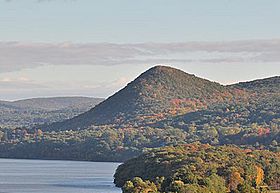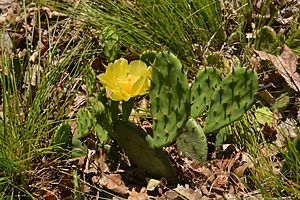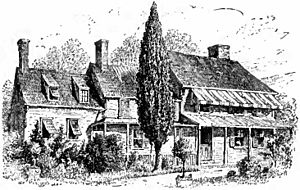Sugarloaf Hill (Putnam County, New York) facts for kids
Quick facts for kids Sugarloaf Hill |
|
|---|---|

Looking north towards Sugarloaf Hill
from the Bear Mountain Bridge |
|
| Highest point | |
| Elevation | 785 ft (239 m) |
| Geography | |
| Location | Philipstown, New York, U.S. |
| Parent range | Hudson Highlands |
| Topo map | USGS Peekskill |
| Climbing | |
| Easiest route | hiking trail |
Sugarloaf Hill is a mountain peak in Putnam County, New York. It stands about 785 feet (239 meters) tall. This hill is part of the beautiful Hudson Highlands area. The Dutch people who explored this region gave it its name. They thought the hill looked like a "sugarloaf," which was a cone-shaped block of sugar common in those days, especially when seen from the Hudson River.
Contents
Exploring Sugarloaf Hill's Shape
Sugarloaf Hill is part of a long, narrow ridge. This ridge runs from the northeast to the southwest, very close to the eastern side of the Hudson River. To the northeast, you can find the peak of Castle Rock. On the west side of Sugarloaf Hill, Route 9D follows along. A small stream flows along the southeast side of the hill and eventually empties into the Hudson River. Towards the northwest, the land gently slopes down to the river.
Hiking to the Summit
The very top of Sugarloaf Hill is about 785 feet (239 meters) high. It's located near the middle of the ridge. There's a special hiking trail that goes up the western side of the hill. This trail is marked with red blazes, which are painted symbols to guide hikers. The trail then continues along the ridge, crosses over the summit, and ends at a fantastic viewpoint. From this spot, which is about 700 feet (213 meters) high, you can see amazing views of the Hudson River.
Unique Plants on Sugarloaf Hill

You might be surprised to find a special plant growing on the rocky ledges of Sugarloaf Hill. It's called Opuntia humifusa, also known as the Eastern prickly-pear cactus. This type of cactus usually grows in warmer, drier places.
Why Cactus Grows Here
So, why does a cactus grow in New York? The estuary of the Hudson River brings warmer ocean air far upstream. This helps keep the area a bit warmer. Also, the sunny, exposed rocks on Sugarloaf Hill provide the perfect conditions for this cactus to thrive. You can find this unique plant growing here and in other parts of the Hudson Highlands.
A Glimpse into History

At the base of Sugarloaf Hill, a large house called Beverley was built in 1758. It belonged to Colonel Beverley Robinson. During the American Revolution, Colonel Robinson was a Loyalist, meaning he supported the British King. Because of this, his house and lands were taken by the American forces in 1777.
Beverley House During the Revolution
The Beverley house became an important place during the war. Several American generals used it as their headquarters. In 1780, Benedict Arnold, a famous American general, chose to live there when he took command of West Point. It was at Beverley that Arnold learned his plan to betray the Americans had been discovered. He quickly fled from the house to a British ship called HMS Vulture.
Sugarloaf Hill Today
After the war, the Beverley house later belonged to Hamilton Fish. Sadly, it was destroyed by a fire in 1892. In 1974, the Osborn family generously donated Sugarloaf Hill to the Taconic State Park Commission. Today, Sugarloaf Hill is part of the Osborn Preserve, which is a beautiful section of Hudson Highlands State Park. It's a great place for people to enjoy nature and go hiking.

